A report published by the American newspaper “Washington Post” stated that the Israeli bombing of the Gaza Strip led to turning entire neighborhoods into dust, and that parts of the Strip may be dangerous after the war for years due to unexploded bombs and the destruction of infrastructure and buildings.
The report by Adam Taylor, a writer in international affairs for the newspaper, explained that the war, no matter how long it lasted, is only the beginning, pointing out that the buildings were leveled, the infrastructure was destroyed, including water and sewage networks, and that many of the weapons that were used in Gaza , including the controversial white phosphorous, can leach into the water supply.
Like World War II
The report quoted Charles Birch, an explosive clearance expert at the United Nations Mine Action Service, who was in Gaza at the height of the bombing campaign, as saying that Gaza is currently filled with hundreds if not thousands of unexploded ordnance, ranging from makeshift rockets to high-tech munitions that The United States provided it to Israel. “The pollution will be unbelievable, like something from World War II,” he added.
Taylor pointed out that unexploded ordnance may be the most widespread threat, because it will last long after the war, and pose risks to civilians for generations. Even in times of relative peace in Gaza, bombs remaining from previous rounds of fighting regularly killed and maimed, and the problem now is exponentially worse. .
Experts were quoted as saying that one in 10 munitions does not explode, and that this number varies greatly depending on the type of weapon, and can be much lower in some newer munitions, and is affected by factors including length and storage conditions, weather and target.
Higher failure rates
“You’re going to have higher failure rates in an urban environment, because a lot of types of munitions are going to soft-land through ceilings,” said James Cowan, who leads the Halo Trust, a non-profit organization that clears land mines.
Taylor said that Gaza will be largely uninhabitable for years given the size of the rubble and the difficulty of removing it in light of the city’s dilapidated high-rise buildings, narrow alleys and underground tunnels, and noted that controlled surface explosions to remove munitions may lead to the detonation of buried munitions.
Inaccurate numbers
Taylor explained that Israel did not issue accurate numbers about the munitions it used, and commented on what Israeli Defense Minister Yoav Galant said last November 1, that Israel had dropped 10,000 bombs on Gaza until that time, as a number that cannot be independently verified.
The writer pointed out that American lawmakers criticized the administration of President Joe Biden for its lack of transparency regarding the number of weapons it sent to Israel, in contrast to the military aid sent to Ukraine.
While the deminers, the report says, have some familiarity with American-made air defense weapons or explosive artillery shells, for example, most have worked less with Israeli-produced precision weapons such as the Spike series of missiles.
High cost
Charles Birch said it could take up to 30 contractors digging through the rubble for more than a month to find and defuse a single bomb in Gaza, at a cost of up to $40,000 per bomb.
This comes in light of the decline in funding for demining efforts, and much public attention is currently focused on Ukraine.



